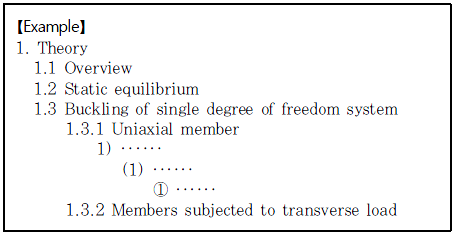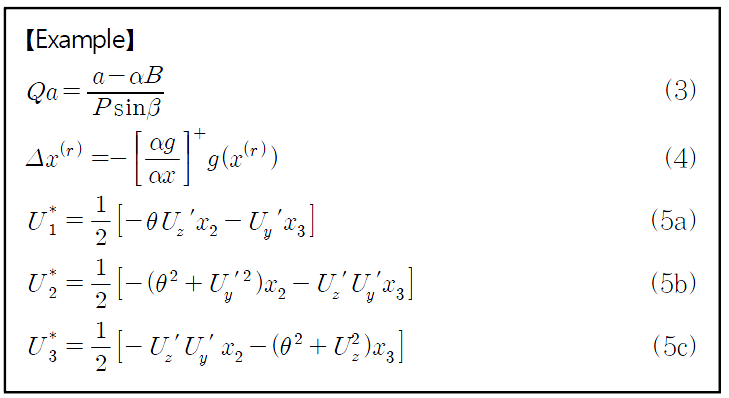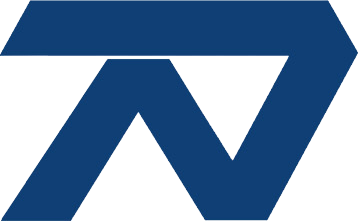Instructions for Authors
COSEIK Paper Submission Guidelines
1. Purpose
This COSEIK Paper Submission Guidelines are intended to set forth the instruction, the format and rules for manuscript submission to the Journal of Computational Structural Engineering Institute of Korea (hereinafter, the ‘Journal’).
2. Manuscript Preparation
2.1 Contributor
Among the contributors, the corresponding author responsible for the manuscript must be a regular member of COSEIK.
2.2 Types of Papers
2.2.1 Research Papers
Research papers are the papers whose contents must include the research and the technological achievement based on creative theory or experiment relevant to the computational structural engineering. No research paper for submission to COSEIK must be previously unpublished or to be published in another journal.
2.2.2 Discussion paper and Answer to Discussion
In cases where anyone wants to raise a question or provide supplemental or different data, document, or opinion with respect to the way of research or the result of any other paper which was already published in the Journal, he or she may submit such data, document or opinion in his or her discussion paper. In those cases, the author of the research paper at issue must answer to that discussion paper. Any discussion paper must be submitted to the Editorial Committee within three (3) months from the date of publication of that research paper at issue and the content of discussion paper will be published together with the answer of the author of that research paper. The Editorial Committee is responsible for the decision of acceptance and supervision of discussion papers.
2.3 Language and Transcription
As a rule, the paper submitted to COSEIK must be written either in Korean or in English. When a foreign word is necessary to be written in the original language because, its meaning is not recognized well even though it is translated into Korean, the foreign language of the word must be written in parenthesis of ‘( )’ together with the translated Korean word. The first letter or all letters of an abbreviation or a proper noun can be capitalized.
2.4 Length of Paper and Publication Fee
The Length of papers is normally no more than eight pages of printed version including drawings, tables, and pictures. The review charge for the paper is exempted in regular review session, and one hundred twenty thousand won (120,000KRW) in express review session. For the papers that do not exceed eight pages, publication fee is one hundred twenty thousand won (120,000 KRW) for the papers to be reviewed in both regular and express review session. For the papers that exceed eight pages, the author must pay additional publication fee of one hundred thousand won (100,000KRW) for each count of two pages, for both cases of regular and express review sessions. In any instances, no paper can exceed sixteen pages in total. As a rule, the length of any discussion paper or any answer to discussion paper should not be more than two pages.
2.5 Format and Size
As a rule, the manuscript for submission must be written in one side of A4-size pages by using a word processor. The margin of top, bottom, left and right must be provided respectively, and the text must be double spaced for the convenience of review and proofreading.
2.6 Submission
The manuscript for review must be submitted online (www.jcoseik.or.kr) accompanied by the online application. The authors must avoid to provide their personal information such as membership, name, company, department or contact number that may identify the authors. As the manuscript passes through a review and is decided to be published, a final version written by using a word processor must be submitted to COSEIK online. Any inquiries related to the submission of the paper can be made via online (www.coseik.or.kr).
2.7 Copyright and Scope of Liability
2.7.1 Copyright of the paper submitted is granted to its authors while COSEIK may have the right to compilation and publication upon the submission of the Copyright Transfer Agreement by the authors. Therefore, the author is responsible for the contents of the paper.
2.7.2 The author should be cautious because they are liable for any claims caused by copyright dispute arisen from quotation of other copyrighted works.
2.7.3 In cases where any mistake or any error in expressions or phrasing is identified after publication of a paper, the correction must be noticed to COSEIK within six months from the date of publication for a correction article to be printed.
2.8 Compliance with the Research and Publication Ethics
2.8.1 The paper submitted must comply with the research and publication ethics provided by COSEIK and the author must submit the Ethic-abiding Covenant prior to the publication of the paper.
2.8.2 For the policies on the research and publication ethics not stated in this instructions, the regulations on research misconduct stipulated by National Reserach Foundation (NRF) of Korea may be applied.
3. Instructions for Preparation of Manuscript
3.1 Constitution of Manuscript
As a rule, the following order is the recommended structure of a manuscript: title, author, affiliation, abstract in English, keywords, introduction, main body, conclusion, acknowledgement, nomenclature, references, abstract in Korean and appendix. The details of each composite are as below:
3.2 Description of Each item
3.2.1 Title
Title must be a clear and concise expression of the paper written in Korean and English. The first letter of each word of English title except for an article, a proposition and a conjunction must be capitalized. A subtitle is not allowed.
3.2.2 Author
The first author or the corresponding author must be a regular member of COSEIK. A dagger mark must be attached for the corresponding author and his or her telephone number and email address must be in the footnote placed in the lower left corner of the first page. The names of authors must be placed immediately below the title. English name (full name) must be written in the order of first name and family name. Authors must provide information such as affiliation, position, etc. If they are under 19 years of age, the final affiliation, position, and the year of school grade must be provided.
< Notation Style of Affiliation and Position >
| Affiliation and Position | Notation Style | |
|---|---|---|
| University | Professor | Name / 00 University / Professor |
| Lecturer | Name / 00 University / Lecturer | |
| Student | Name / 00 University / Student | |
| Postdoctoral Researcher | Name / 00 University / Postdoctoral Researcher | |
| High or Middle School |
Student | Name / 00 High or Middle School / Student |
| Teacher | Name / 00 High or Middle School / Teacher | |
3.2.3 Abstract
In the abstract, the author must briefly state the subject, discussion and result of research in one paragraph. The abstract must be written both in English and in Korean. The texts of both language versions must match with each other. The length of English abstract must not exceed 200 words while that of Korean abstract must not exceed 400 characters.
3.2.4 Keywords
Three to seven keywords must be so chosen that they best describe the contents of the paper. They must be placed immediately below both English and Korean abstracts respectively.
3.2.5 Introduction
Introduction should be stated in short and clear enough to describe the subject, scope and method of research not to mention the background that anyone can figure out them without referring to the other papers.
3.2.6 Main Body
Main body should describe the details of basic assumption, basic theory, new theory and method, if it is a research based on an experiment, the method and contents of that experiment. In addition, a justification of the paper at issue must be proven compared to the other papers.
1) Headings of Chapter, Section, Paragraph and Clause Headings of chapter, section, paragraph and clause must be marked as below example. As a rule, when the heading of them is in English, the way marking the title must be followed. Otherwise, except in cases of necessity, those headings should be translated into Korean if possible, and it is recommended that the English text to be added within the paragraph text.
2) Formulas and Symbols
Various formulas, signs and symbols used in the text should be the ones generally used and, if it is necessary, the list of them must be provided. A fractional number should be marked as ‘3/4’ if possible and a comma should be used to mark every three digits in a long number, beginning at the right. Formulas should be stated in a unified simple form if possible by curtailing the parts of expansion or inducement so that those parts may be supplemented in the text sentences. A formula must not be included in the line of sentences and thus it must be placed in a separate line. A symbol or a variable must be defined in a sentence at the place where it is initially described. The same font for a symbol or a variable must be used when it appears in both formula and sentence. The same symbol or variable must not be used for indicating more than one meaning. The formulas are to be consecutively numbered through the entire text and the number must be placed at the end of right side of formulas. However, when the formulas at issue are so similar that the serial numbers are not necessary, the same number can be used but an English alphabet must be added to the same numbers in order to differentiate those formulas.
3) Unit
All units should comply with SI units. Otherwise, SI units must be parenthesized.
4) Table, Drawing and Picture
(1) In cases where a drawing or a picture is used, a letter-quality original, which is not copied, should be used if possible and the author should make such drawing or picture considering the print size. Even when its size is so large that a size reduction is required, the drawing or the picture should not be too small to be vague. In this case, a paper publication may be rejected due to the lack of definition and clarity of drawings or pictures if it may cause the qualification of the paper at issue. When a color drawing or picture is necessary, the author must pay additional cost of one hundred thousand won (150,000 KRW) per one page.
(2) Drawings, pictures and tables must be consecutively
numbered through the entire paper. While the title and description of drawings and pictures must be placed in the center of the bottom, those of tables must be placed in the center of the top. In this case, those title and description must be written in English and only the first letter must be capitalized. Also, a footnote for the symbol or the code referred in a table, if necessary, should be placed immediately below that table.
(3) In cases where drawings and tables are interrelated, the marks including (a), (b) or (c) can be used and an explanation or a description can be added.
5) References
In citing a reference book or an article, the name of author and the publication year must be given. With respect to the author’s name, a family name must be used if it is a Korean reference book or article, while only last name may be written for an English one. In cases where the number of authors of a reference book are more than one, only the name of corresponding author such as ‘Hong et al., 2012’ or ‘Wood et al., 2012’ must be given for a Korean paper. Spacing of word or using punctuation marks must comply with the following example.
3.2.7 Conclusion
Conclusion should state and provide the most valuable and important result of research. It must also describe the value, contributions and application of research.
3.2.8 Acknowledgement
Acknowledgement is a statement expressing author’s gratitude by citing the name of certain person or institute that has supported financially or academically. It is recommended that an excessive expression should be avoided.
3.2.9 List of Symbols and Variables
The list of symbols and variables should be summarized alphabetically in the place before references.
3.2.10 References
References must be written in English and the reference books and articles must be arranged alphabetically by the last name of corresponding author. When the corresponding authors are same, they must be arranged in the alphabetical order of the name of the second author. In cases where the number of authors is more than three, the same ways of arrangement described above must be used. When the names of authors are the same, the reference book or article published earlier must come first.
1) Articles of Academic Journal
Name of author (Publication year), Title, Name of journal (italic font for journal), Volume (issue), Page cited.
2) Single book of reference
Name of author (Publication year), Title of book (italic font), Publisher, Place of Publication, Number of entire pages
3) Report
Name of author (Publication year), Title of report, Number of report, Name of publishing institute, Place of publication, Number of entire pages
4) Journal of academic conference
Name of author (Publication year), Name of academic conference (italic font), Sponsoring academic society or institute, Volume (issue), Page(s) cited
5) Thesis
Name of author (Year of degree grant), Title of thesis, Name of university/college which granted the thesis, Number of entire pages
3.2.11 Appendix
Data or document supplementing the text of paper or detailed description for the things including the inducement process of formula, if necessary, may be attached as appendix. In this case, the appendix must be referred in the text.
4. Review Process
4.1 Reviewers may be nominated to the chairman by the Editorial Committee member and then the chairman may ask them to review the papers submitted. For the papers in express review session, the author may recommend up to 5 reviewers who are able to participate in the review process in fair and reasonable manner. These reviewers must be recommended to the Editorial Committee upon the submission of the paper.
4.2 Paper submitted must be reviewed by three reviewers. The reviewer must be a regular member of COSEIK having a Ph.D. degree in relevant field of study or being equivalently qualified. However, if necessary, when the nature of paper is considered, an outside specialist may be invited for the review.
4.3 The Editorial Committee shall decide the paper as ‘acceptance’, ‘rejection’ or ‘re-review’ for the papers reviewed in the regular review session. For the papers reviewed in the express review session, only the decision of ‘acceptance’ or ‘rejection’ may apply. Papers accepted for the publication shall be noted as either ‘acceptance with no-revision’, or ‘acceptance with revision’.
4.4 In cases where more than two reviewers make a decision of acceptance of a paper submitted, the paper may be published in the Journal.
4.5 The paper subject to the publication after revision must be re-reviewed by the same reviewers who initially reviewed the paper. However, in this case, the reviewers cannot make a decision of ‘re-review after revision’ again and thus they must make a decision of either ‘acceptance’ or ‘reject’. The re-review period must be within two weeks from the date of the request.
4.6 For the regular review session, the first review shall be completed within three weeks from the date of receiving a paper. For the express session, the paper shall be reviewed within 10 days upon the date of the receipt. Otherwise, a request for the review's completion can be made and, in this case, as a rule, the review period may be extended up to two weeks from the date of the request in case of the regular review session.
4.7 In cases where more than two reviewers make a decision of reject of a paper submitted, the Editorial Committee has to deliver a final decision that the paper will not be able to be published in the Journal.
4.8 In cases where a corresponding author does not respond to the Editorial Committee’s decision of re-review after prior revision for more than one month from the notification of such decision, the Committee may request (one time only) the author to make a revision. In this case, if no response to such request is received within one month from the date of request, the Editorial Committee may make a decision of rejection of the paper for publication.
4.9 Author may be able to raise an objection to the decision of the Editorial Committee.






 Journal of the Computational Structural Engineering Institute of Korea
Journal of the Computational Structural Engineering Institute of Korea








